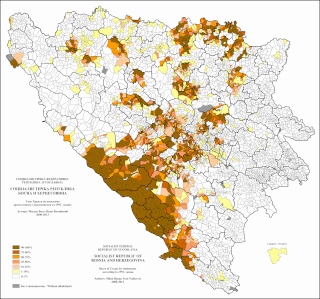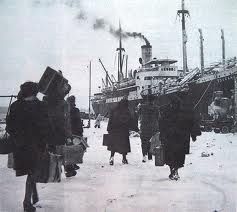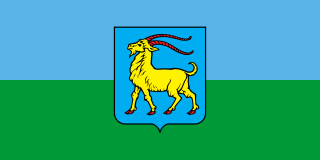
Dalmatia is one of the four historical regions of Croatia, alongside Central Croatia, Slavonia, and Istria, located on the east shore of the Adriatic Sea in Croatia.

Istria is the largest peninsula within the Adriatic Sea. Located at the top of the Adriatic between the Gulf of Trieste and the Kvarner Gulf, the peninsula is shared by three countries: Croatia, Slovenia, and Italy, 90% of its area being part of Croatia. Most of Croatian Istria is part of Istria County.
Bunjevci are a South Slavic sub-ethnic group of Croats living mostly in the Bačka area of northern Serbia and southern Hungary, particularly in Baja and surroundings, in Croatia, and in Bosnia-Herzegovina. They presumably originate from western Herzegovina. As a result of the Ottoman conquest, some of them migrated to Dalmatia, from there to Lika and the Croatian Littoral, and in the 17th century to the Bácska area of Hungary.
Regionalism is a political ideology that seeks to increase the political power, influence and self-determination of the people of one or more subnational regions. It focuses on the "development of a political or social system based on one or more" regions, and/or the national, normative, or economic interests of a specific region, group of regions or another subnational entity, gaining strength from or aiming to strengthen the "consciousness of and loyalty to a distinct region with a homogeneous population", similarly to nationalism. More specifically, "regionalism refers to three distinct elements: movements demanding territorial autonomy within unitary states; the organization of the central state on a regional basis for the delivery of its policies including regional development policies; political decentralization and regional autonomy".

Italo-Western is, in some classifications, the largest branch of the Romance languages. It comprises two of the branches of Romance languages: Italo-Dalmatian and Western Romance. It excludes the Sardinian language and Eastern Romance.
The History of Dalmatia concerns the history of the area that covers eastern coast of the Adriatic Sea and its inland regions, from the 2nd century BC up to the present day. The region was populated by Illyrian tribes around 1,000 B.C, including the Delmatae, who formed a kingdom and for whom the province is named. Later it was conquered by Rome, thus becoming the province of Dalmatia, part of the Roman Empire. Dalmatia was ravaged by barbaric tribes in the beginning of the 4th century.

The Istrian–Dalmatian exodus was the post-World War II exodus and departure of local ethnic Italians as well as ethnic Slovenes and Croats from Yugoslavia. The emigrants, who had lived in the now Yugoslav territories of the Julian March, Kvarner and Dalmatia, largely went to Italy, but some joined the Italian diaspora in the Americas, Australia and South Africa. These regions were ethnically mixed, with long-established historic Croatian, Italian, and Slovene communities. After World War I, the Kingdom of Italy annexed Istria, Kvarner, the Julian March and parts of Dalmatia including the city of Zadar. At the end of World War II, under the Allies' Treaty of Peace with Italy, the former Italian territories in Istria, Kvarner, the Julian March and Dalmatia were assigned to now Communist-helmed Federal Yugoslavia, except for the Province of Trieste. The former territories absorbed into Yugoslavia are part of present-day Croatia and Slovenia.

Croatisation or Croatization is a process of cultural assimilation, and its consequences, in which people or lands ethnically only partially Croatian or non-Croatian become Croatian.

Dalmatian Italians are the historical Italian national minority living in the region of Dalmatia, now part of Croatia and Montenegro.

The Italian language is an official minority language in Croatia, with many schools and public announcements published in both languages. Croatia's proximity and cultural connections to Italy have led to a relatively large presence of Italians in Croatia.

The Dalmatian is a breed of dog with a white coat marked with dark-coloured spots. Originally bred as a hunting dog, it was also used as a carriage dog in its early days. The origins of this breed can be traced back to Croatia and its historical region of Dalmatia. It is thought that early ancestors of the breed were certain breeds of pointers and a spotted Great Dane. Today, it is a popular pet and many enthusiasts enter Dalmatians into kennel club competitions.

Istrian Italians are an ethnic group from the Adriatic region of Istria in modern northwestern Croatia and southwestern Slovenia. Istrian Italians descend from the original Latinized population of Roman Histria, from the Venetian-speaking settlers who colonized the region during the time of the Republic of Venice, and from the local Croatian people who culturally assimilated.

Italians of Croatia are an autochthonous historical national minority recognized by the Constitution of Croatia. As such, they elect a special representative to the Croatian Parliament. There is the Italian Union of Croatia and Slovenia, which is a Croatian-Slovenian joint organization with its main site in Rijeka, Croatia and its secondary site in Koper, Slovenia.
The Italo-Dalmatian languages, or Central Romance languages, are a group of Romance languages spoken in Italy, Corsica (France), and formerly in Dalmatia (Croatia).

Dalmatian identity, or sometimes also Dalmatianism, Dalmatianness or Dalmatian nationalism, refers to the historical nationalism or patriotism of Dalmatians and Dalmatian culture. There were significant Dalmatian nationalists in the 19th century, but Dalmatian regional nationalism faded in significance over time in favor of ethnic nationalism.

Dalmatian city-states were formerly Roman municipalities in Dalmatia where the local Romance population survived the Barbarian invasions after the fall of the Western Roman Empire in the 400s CE. Eight little cities were created by the indigenous Illyro-Roman inhabitants of the region, who maintained political links with the Eastern Roman Empire, which in return defended these cities, enabling their commercial trade with Byzantium.

The Arbanasi dialect is a dialect of Gheg Albanian that is spoken in long-standing diaspora communities of Albanians in Croatia. Its speakers originated from the region of Kraja, and moved to Croatia in the early 18th century.

Istrian identity, also known as Istrianity, Istrianism or Istrianness, is the regionalist identity developed by the inhabitants of the part of Istria located in Croatia. Istria is the biggest peninsula in the Adriatic Sea and a multiethnic region divided between Croatia, Italy and Slovenia. Italians and Slovenes live in both the Italian and Slovene parts, while in the Croatian part, there are Croats, Italians, Istro-Romanians and Istriot-speakers, as well as some non-native minorities. Most of Croatian Istria is located in the Istria County of the country. Istria is the region of Croatia where regionalist sentiment is the strongest.













